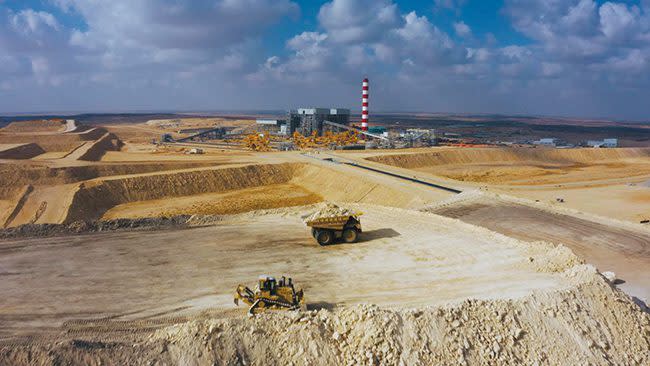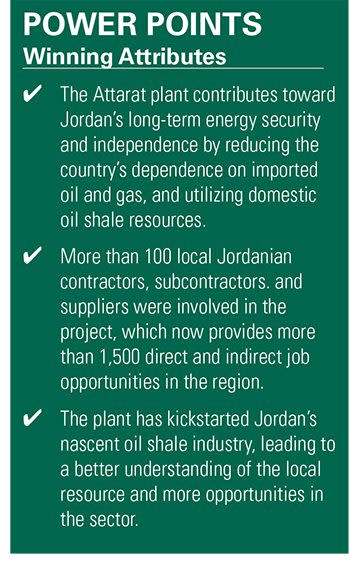Attarat Power Plant Unlocks Domestic Energy Source for Jordan
 |
Oil shale doesn’t fuel a lot of power plants around the world, but in Jordan, it’s a vital option, offering energy security and independence. The success of the Attarat Power Plant in capitalizing on this valuable indigenous resource led to its selection as a POWER Top Plant award winner. Jordan is a country whose fuel and electricity industries are mostly dependent on imported crude oil and natural gas. Its only important indigenous source of energy is oil shale. Yet, oil shale is abundant in Jordan. According to a report published by the country’s Ministry of Energy and Mineral Resources, Jordan possesses more than 65 billion tons of geological oil shale reserves, ranking it eighth in the world, ahead of countries such as China, which is more than 100 times its size.
A Unique and Challenging Resource
Oil shale is a sedimentary rock rich in organic matter known as kerogen, which when heated, breaks down and releases hydrocarbon. Oil shale can be thought of as a precursor to oil and natural gas; with more pressure and over longer geological time, the kerogen would heat to its oil and gas window to release crude oil or natural gas. Oil shale is extracted using conventional mining techniques. It is crushed and burned as fuel to produce electricity or heated up using a retorting system to produce synthetic shale oil. The liquid shale oil is a synthetic crude oil that can be treated and refined into other petroleum products, such as diesel, gasoline, and jet fuels. Historically, very little has been done to exploit Jordan’s oil shale reserves, but that has changed in recent years. One project that has tapped into the resource is the Attarat Power Plant. It was constructed about 110 kilometers southeast of Amman, Jordan’s capital and the largest city in the country. Attarat’s two 235-MW units, which entered commercial operation in October 2022 and May 2023, respectively, were brought online to burn oil shale and produce electricity. The two units are now capable of supplying about 15% of Jordan’s annual electricity demand. Mining and burning oil shale are challenging compared to other solid fuels. Jason Pok, CEO of Attarat Power Company, explained that the average thickness of the overburden over the resource block is about 60 meters (m). Meanwhile, the average mineable oil shale layer thickness is only about 30 m. Oil shale also has a low calorific value compared to other fuels. Specifically, Jordan’s oil shale has an average lower heating value (LHV) of 3.8 Megajoules/kilogram (MJ/kg, 1,660 Btu/lb). Its moisture content is 15% to 22%, and the ash content is not less than 60%. Meanwhile, there is also significant variation in the LHV and other chemical composition at the mine, which must be managed. Fly ash generation can be a problem and crushing issues are also prominent.
Overcoming Problems
To manage these challenges, Attarat uses a variety of methods. At the mine, a plan was developed to manage and expand the open mouth mine (Figure 1). Remarkably, more than 40 pieces of mining equipment are used around the clock in the process. Jason Pok said a revised blending schedule and different mixing methods have increased the fuel’s LHV to as high as 4.1 MJ/kg (1,763 Btu/lb).
 |
1. Attarat has the biggest mine in Jordan, producing 10 million tonnes of oil shale per annum. Courtesy: Attarat Power Company |
Attarat’s Sumitomo SHI FW circulating fluidized bed (CFB) boilers are designed to deal with the high ash levels found in oil shale. By recirculating the oil shale through a cyclone, CFB technology achieves a high combustion efficiency. Sumitomo SHI FW says CFB boilers are designed to withstand the harshest conditions and can better resist tube corrosion, wear, and ash adhesion, making high-temperature, high-pressure steam conditions possible for all fuels. The Attarat boilers operate at a main steam pressure of 166 bar (about 2,400 psi) and main steam and reheat steam temperature of 539C (about 1,000F). To deal with the high ash content in the fuel, the boilers are installed with 60 high-energy sootblowers, spring hammers, and acoustic cleaners to enhance the boiler ash cleaning. The plant has an automatic ash handling system. Concerning the usage of high amounts of oil shale with high ash content and the resultant huge quantity of ash to be handled, these have forced the plant to keep a large number of spare parts on hand. Furthermore, the maintenance team is often required to work around the clock to manage the associated challenges. Nevertheless, the units have operated reliably since commissioning. “The plant achieved availability of about 80%, as required by the power purchase agreement, for the first two contract years with gross generation of 3,888 GWh,” Jason Pok reported.
The Construction Contractors and Suppliers
Guangdong Power Engineering of China Energy (GPEC) was the main engineering, procurement, and construction (EPC) contractor performing the turnkey project. At the peak time of construction, there were more than 4,000 workers onsite including all contractors, subcontractors, suppliers, and service providers. All workers who needed to be trained and certified were trained onsite by the Health, Safety, and Environmental (HSE) and Quality teams prior to their work commencing. “There were challenges finding the right people during the commissioning period due to various restrictions as a result of COVID-19,” Jason Pok recalled. “We managed to source qualified people from different regions to complete the commissioning work.” As previously mentioned, Sumitomo SHI FW supplied the plant’s boilers. Siemens Energy supplied the steam turbines and generators, as well as a T3000 distributed control system and programmable logic controllers for the project. Four sets of oil shale reclaimers and stackers were supplied by Dalian Huarui Heavy Industry Group Co. Ltd. and Flender. Equipment for two sets of semi-mobile crushing stations for the mining area was supplied by Beijing MMD Mining Machinery Co. Ltd. and MMD Asia Pacific Ltd. Meanwhile, the two air-cooled condensers, which have 30 fans each, were provided by Shanghai Electric-SPX Engineering & Technology Co. Ltd.
Advanced Technology
A notable solution the Attarat plant has implemented to improve plant efficiency and availability involves a high-tech artificial intelligence–based monitoring system for the boilers. Supplied by Sumitomo SHI FW, the IZANA Digital Services platform features several innovative digital products: Envelope, Boiler Bed Management, Boiler Leakage Detection Program, and Fouling Management. Sumitomo SHI FW says these tools “optimize a boiler’s operating capacity and environmental performance, enhance usability, and cut operating costs.” The Envelope solution is designed to increase a plant’s operating efficiency. The technology is also said to increase fuel flexibility and production capacity of a boiler, while lowering maintenance costs. Boiler Bed Management, meanwhile, helps avoid boiler downtime caused by bed agglomeration and sintering. The product is said to increase not only a boiler’s reliability, but also its usability for burning more challenging fuels. It reportedly optimizes sand use in boilers, which means less sand transportation to a landfill, reducing transportation costs. Boiler Leakage Detection Program helps identify boiler tube leaks quickly, which allows an early response and helps minimize damage resulting from leaks. This reduces downtime and repair costs. Lastly, Fouling Management is an optimization application for sootblowing. The application analyzes the cleanliness of heat surfaces in the boiler and automatically suggests the optimum timing for the next steam-powered sootblowing. The operating model maintains peak performance and saves energy by carrying out sootblowing at the best time and only when truly needed.
Key Safety and Environmental Control Systems
The plant design is based on World Bank guidelines, which include strict environmental monitoring aspects. Among the key items being monitored by the program are flue gas emissions and water consumption. “Our boilers were designed with the latest technology to keep the gaseous emissions within standard code limits,” said Jason Pok. “In addition, the plant uses advanced Electrostatic-Fabric Integrated Precipitators (EFIPs). Emission rates are not only monitored directly at the source/stack, but also through an ambient Air Quality Monitoring System (AQMS) established at early stages of the project.” Most of the water supply for the facility comes from brackish underground wells and is utilized for dust suppression in mining and ash disposal. “We minimized the use of water by implementing our air-cooled condenser system by which the steam is cooled by air rather than by water,” Jason Pok noted. “Much effort is also put into wastewater treatment, where all types of wastewaters are treated and reused also in plant operation and onsite irrigation,” he added.
 |
Management has also placed great emphasis on working safety. Since the commissioning of Unit 2, the station has recorded more than 5.5 million man-hours of work without a lost-time injury. “Attarat goes beyond generating electricity,” said Bader Al Neif, head of Public Relations with Attarat Power Company. “It acts as a breakthrough for Jordan’s energy sector, paving the way for future oil shale projects in Jordan and the region.” The editors of POWER couldn’t agree more, and as such, are honored to recognize the Attarat plant with a 2024 POWER Top Plant Award in the fossil fuel category. Congratulations to the entire project team!
—Aaron Larson is POWER’s executive editor.


